Making Sense
/1 Comment/in Flowers, Gardening, Planning, Vegetables/by Lee ReichLilies, More Than Just Pretty
I’m triply thankful for the lily stems in the vase in the kitchen.
First, for their beauty. The large, lily-white (of course) petals flare out into trumpets, from whose frilly throats poke groups of rust-red anthers and single tear-capped stigmas. The petals spread about 8 inches wide from one side to the other, and the single stalk I plunked into the vase sports six of them!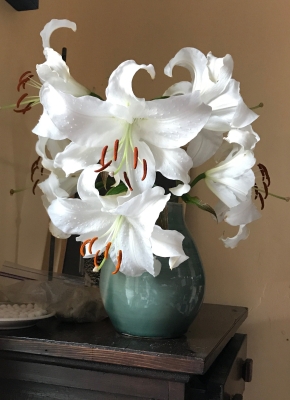
Second, I’m thankful for the lilies’ fragrance. The heady, sweet fragrance fills the whole room.
And third, I’m thankful that the plants, cut from outdoors where they share a bed with staked Sungold tomato plants, are alive. They’ve been threatened by a relatively new pest, the lily leaf beetle (Lilioceris lilii). This European pest made its North American debut in Montreal in 1945, and its debut on my farmden in 2015.
Lily leaf beetle can be controlled by sprays, even organic ones such as Neem or spinosad. But I’m not keen on spraying anything on plants rubbing elbows with edibles, in this case my Sungold tomatoes.
The beetles’ bright red color makes them easy to spot, at which point they can be crushed. Battling the beetle mano a mano is a viable control for a backyard planting. This was my approach a couple years ago. With other garden distractions and many crown imperial (Fritillaria) plants, which also are attacked by the beetle, I abandoned any efforts to control the beetle.
Yes, I saw some beetles on the lilies this season; yes, the plants are still doing well. Plants can tolerate a certain amount of pest damage and still do fine.
Play It Again Sam
My awesome lilies aren’t just any old lilies. They’re true lilies (Lilium species), not daylilies (Hemerocallis species). Once we’ve narrowed down “lily” to the genus Lilium, there are about 100 species within that genus from which to choose.
My lily is one of many varieties of Asiatic hybrid lilies. Its name: Casa Blanca. I highly recommend growing it.
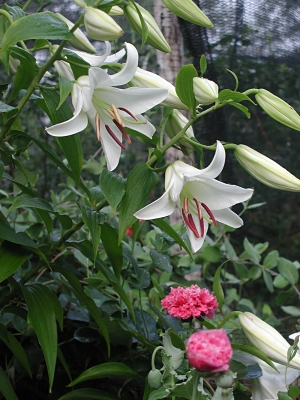
Casablanca lily in the garden
Popeye’s Delight, Later
With eyes and nose taken care of, let’s move on to another of the senses, taste. I’d like some spinach. But I can’t have it — yet. I can plant it very soon, though, and then in a month or so I can be eating it.
So why didn’t I plant it a month ago so I could be eating it now? The reason is that spinach is a long day plant, which flowers (aka “goes to seed”) during summer’s long days. Planted a month ago, even two months ago, and after making a rosette of a few leaves the plant would pump its energy into flowers and seeds. Besides yielding a paltry harvest of leaves, that whole “going to seed” thing also ruins the flavor of the leaves.
Actually, it isn’t long days that make spinach gustatorily morph from Dr. Jekyll to Mr. Hyde; it’s short nights. (Photoperiodism, the name for this response, was originally though to be the response to daylength; calling it a response to “daylength” stuck even after it was discovered that the response was to the length of the the night.) Beets, gladiolas, lettuce, and radishes are also “long day plants.”
Photoperiod doesn’t work alone in prodding plants to grow or flower. Temperature, either before germination or while the plants are growing, also figures in, as does light intensity and soil moisture. Spinach usually flowers when days are 14 or more hours long (more correctly, short nights that are 10 or less hours long), but will also do so following 8 hour days (16 hour nights) if the seeds are chilled.
Nights are now just over 10 hours long so I can plant spinach. While the plants are growing, cooler temperatures, which are coming this way, and adequate water, which my plants will get thanks to drip irrigation, also factor in to keep spinach from going to seed. So the spinach that I sow today will put all its energy into growing large and tasty leaves.
Peas, Please
A taste of peas would also be nice. The spring harvest was good. Still, some gardeners successfully plant peas in summer for an autumn harvest. Not me.
Daylength isn’t what messes up late sown peas, for me, at least. Heat is. Peas languish during hot weather, common through August and even lingering into early autumn. So the peas grow poorly, and if they do weather the hot weather, they are apt to be struck down by the first frost of autumn.
I’ve heard that Wando is a pea variety that can take some heat. I haven’t tried for an autumn harvest for many, many years. With climate change, perhaps autumn peas are worth another try.
Fruit, Again, With Nod To Michael Jackson
/0 Comments/in Fruit, Gardening, Planning, Pruning/by Lee ReichBlackcaps Redux, This Season
I took a cue from Michael Jackson today when pruning my black raspberry (a.k.a. blackcap) plants. Not that I had to prune them today, or even this time of year. But I couldn’t stand looking at the tangled mass of thorny canes. And, more importantly, the tangled mass would make harvest, slated to begin in a couple of weeks or so, a bloody nightmare.
(Most blackcaps bear only once a year, in early summer, so tidiness would be the main reason to prune conventional blackcaps now. Pruning would also let remaining canes bathe in more light and air, reducing the threat of diseases. My blackcap plants, though, are the two varieties — Niwot and Ohio’s Treasure — that bear twice a year; hence, my pruning now to make picking the soon-to-ripen second crop less intimidating.)
All blackcaps have perennial roots and biennial canes. Typically, the canes just grow their first year, flower and fruit their second year, then die. Niwot and Ohio’s Treasure differ in bearing on both one-year-old canes and on new canes. I picked the early summer crop from canes that grew last year. And now my mouth is watering as I look forward to the late summer crop, which will be borne on canes that just started growing this season.

Pruning is straightforward. I started by lopping right to ground level all the canes that bore the early summer crop; they’re dying anyway. Step two is reducing the number of new canes, selectively keeping the fattest and healthiest-looking ones, and lopping all others to ground level. Even then, I reduce their number to the best six of them. That’s it. Easy, as long as the thorns are avoided.
My blackcaps are in a row, three feet apart. An iron pipe sunk into the ground next to each plant provides support for each plant’s clump of stems. With pruning finished, I tied a piece of rope to the pipe and then around the clump of stems, a gloved hand cozying the thorny stems into position while my ungloved hand tied the rope, à la Michael Jackson.
Rotten Plums
I wish that pruning was all that my plum trees needed. With this being such a good year for fruits generally, I was very hopeful for a good crop. And they looked fine up until a week ago, when the fruit started ripening — and rotting.
Brown rot is the culprit, mostly the handiwork of the fungus Monolinia fruticola. Characteristic powdery, gray masses of spores form on the surfaces of rotting fruits, which eventually dry to become “mummies.” Brown rot is not new to me; I’ve experienced it on peaches, nectarines, and plums in the past. It also attacks apricots, cherries, and other “stone fruits” (Prunus genus). Typically, a plant bears well for a couple of years while the fungi are building up, and then full-fledged, annual attacks begin.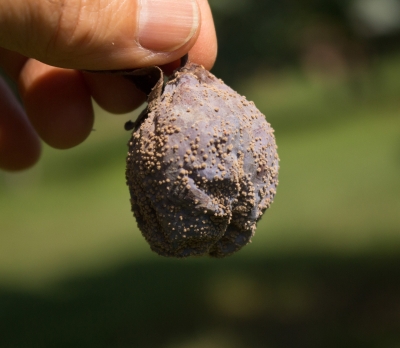
The usual recommendation to hold the fungus at bay is, first, to remove sources of inoculum by cleaning up all infected fruit in summer and mummies in winter, and pruning away dead, infected twigs. That’s quite a job on a big plum tree.
I sprayed my trees with sulfur many times this past spring. Sulfur is an organically approved fungicide, used by gardeners and farmers for thousands of years, that is effective against brown rot. But only for a few days. Hence my repeated sprays, evidently not repeated enough.
The easiest approach would be for me to grow brown rot resistant varieties.
Plumquest Begins
So now I am embarking on a plumquest, my search for plums that taste good and are resistant to brown rot. Resistant genes must lurk somewhere — actually right in my yard, on the wild plums. They hardly ever show fuzzy grayness; they also don’t taste very good.
I now remember a pertinent page I photocopied many years ago. Shuffling through piles of papers on my desk, I come across the page, from a scientific-looking paper, entitled “Range of known genetic traits in Plum cultivars.” That’s a start, and the list on the page includes one of my favorite plums, the Green Gage, also known as Reine Claude Verte, as resistant. Shiro, which I grow with some success, is only listed as “tolerant.”
My next queststep is on the web, bringing me to a publication entitled “The Cultivated Native Plums and Cherries,” authored by Liberty Hyde Bailey in 1892. I immediately ordered a reprint to make it easier to sort through the many varieties and their gustatory and pest potentials.
Once suitable varieties are identified, the next queststep is to locate trees or, more likely, stems for grafting, to bring here to the farmden. I will report on my plumquest as events unfold.
A Cardinal And A Jewel
/8 Comments/in Flowers, Gardening/by Lee ReichAnd This Year’s Winner Is . . .
Organizations annually tout their “plant of the year.” There’s the Perennial Plant Association’s 2017 plant of the year butterfly weed (Asclepias tuberosa); Proven Winners 2017 Landscape Plant of the Year is Yuki Cherry Blossom Deutzia; American Conifer Society Collectors’ Conifer of the Year is Primo Eastern Arborvitae (Thuja occidentalis ‘IslPrim’); Assembly magazine’s 2016 Plant of the Year is Bosch Rexroth . . . whoops, the last is an assembly plant (hydraulic motors and pumps). Anyway, you get the picture.
How about a new category, the Weed of the Year? Here on my farmden, I nominate and elect jewelweed (Impatiens capensis). This weed is all over the place this year, even far from where it’s been in the past. For this weed, being all over the place is its only flaw.
On the positive side, jewelweed is a pretty plant with very succulent stems sporting orange, sometimes yellow flowers. 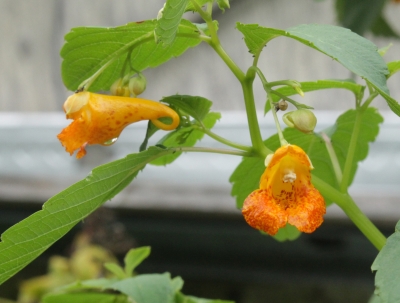 It’s also been called touch-me-not for the way its seed capsules burst open with the slightest touch to project their seeds many feet — a useful characteristic for helping a weed spread although it doesn’t explain jewelweed’s spreading here in one season over a hundred feet and to the other side of my house. It’s close relative, the widely planted annual flower, impatiens, does the same thing without becoming weedy; both plants also enjoy and flower in either sun or deep shade.
It’s also been called touch-me-not for the way its seed capsules burst open with the slightest touch to project their seeds many feet — a useful characteristic for helping a weed spread although it doesn’t explain jewelweed’s spreading here in one season over a hundred feet and to the other side of my house. It’s close relative, the widely planted annual flower, impatiens, does the same thing without becoming weedy; both plants also enjoy and flower in either sun or deep shade.
Jewelweed often grows as a neighbor to poison ivy, which perhaps by some odd reasoning (to me) gave it a reputation for use as a treatment for poison ivy. My friend Bob, usually a clear thinker and very susceptible to poison ivy, decided to treat his rash, one year with jewelweed. He reported a success, as an afterthought mentioning that he applied it in conjunction with cortisone. (I’ll expect a lot of feedback, testimonials for jewelweed.)
Jewelweed’s main asset is how easy it is to remove. Even large stalks lift easily out of the ground, roots intact, with minimal soil disturbance. A machete or scythe slices easily through the stalks without the slightest resistance to decapitate the plants.
Each year in the garden is different. Jewelweed’s plans for next year won’t be evident until next June.
Red In The Shade!
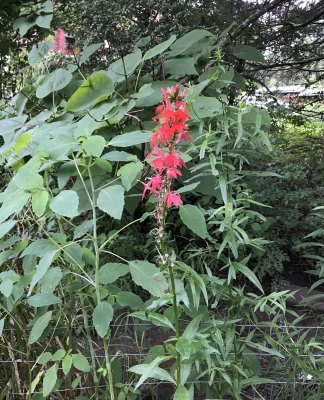
Cardinal flower I planted
Slicing through a stand of jewelweed with my scythe in the deep shade along the seasonal, small stream (a ditch) in front of my property, I was taken aback by a 3-foot-high spike of fire engine red flowers. More scything, and then another spike appeared. I thought back to spring, and remembered planting cardinal flower (Lobelia cardinalis) along the stream/ditch this past spring.
Cardinal flower never ceases to take my breath away. Deep shade is not usually home to lots of showy flowers, and especially not flowers in traffic stopping colors. Only a few times in my life have I come upon cardinal flowers in the wild, and — you guessed it — each time they took my breath away.
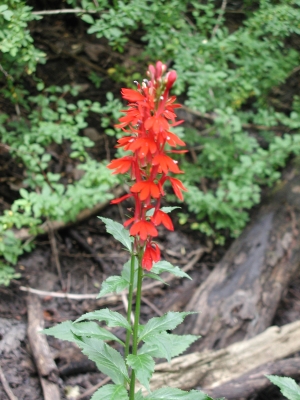
Wild cardinal flower
Each time they were also in deep shade alongside water. Hence my choice of site for last spring’s planting.
Cardinal flowers are easily grown from seed, and no need to have a lot of them for bold effect. The plant to grow is the species, not one of the “improved” varieties. Many varieties have been bred or selected, including Alba (white flowers), Heather Pink, Angel Song (salmon and cream flowers), Ruby Slippers, and Twilight Zone (pink flowers). Color of the straight species is usually red, a very pure red, untainted by a hint of blue as are so many other red flowers.
Two Weeds(?)
Jewelweed and cardinal flower have much in common: both are native, both grow in shade, and both are pretty plants. Jewelweed is a self-seeding annual.
Cardinal flower is a perennial, unfortunately a short-lived perennial. It does self-seed to some degree for new plants to replace dead ones, but not enough for my needs. I grew my originals from seed, which is not at all difficult, and intend to do so again. If only cardinal flower could learn some reproductive habits from its neighbor in the shade.

